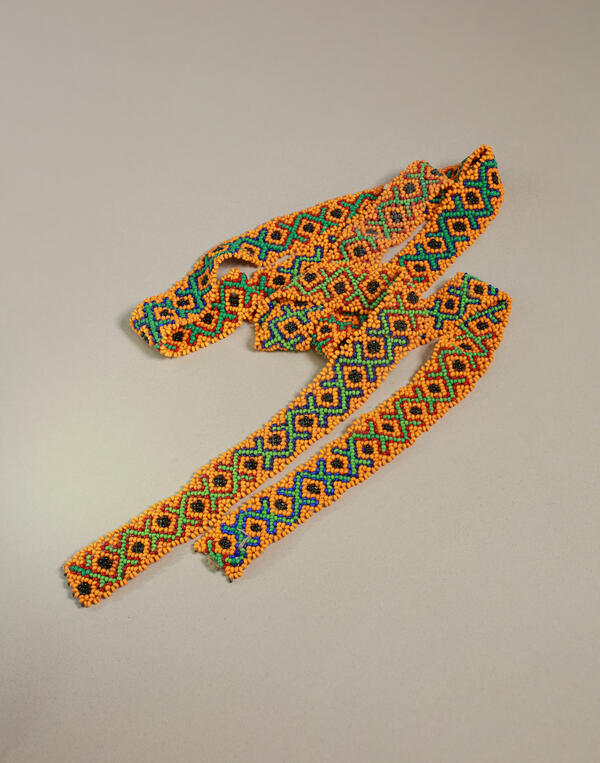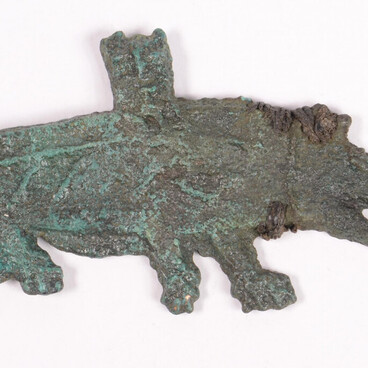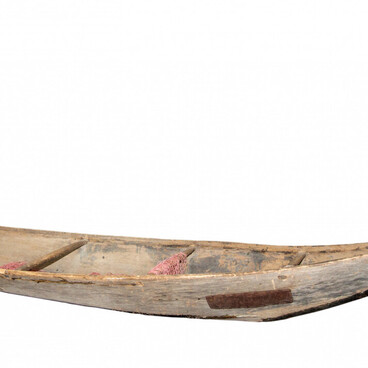The Khanty decorated fur coats, woolen clothes and traditional shoes with ornaments. Ornamental art developed in various ways among different groups of the Khanty. Among the Salym Khanty, after the development of Siberia, it was practically lost along with traditional clothing and way of life. The Yugan Khanty, however, preserve the art to this day. Their ornament is distinguished by a variety of plots, severity and clarity of the pattern design.
To create patterns, the Khanty women used different materials: birch bark, fur, rovduga (suede), broadcloth. They sewed with purchased metal needles, but before they used homemade ones — made from the leg bones of a reindeer or a squirrel, fish bone. When sewing, they put a thimble without a bottom on the index finger — a homemade bone thimble or a purchased metal one. The needles were stored in needle cases, which were made of cloth, fur, cotton fabrics.
Ornaments were often beaded. When and how this material appeared in Siberia, it has not yet been found out for sure. Researchers believe that merchants who came to buy furs could have brought it. Usually, they brought multi-colored opaque beads, sometimes hand-carved from shells. The Khanty purchased white, green, blue, and red beads. White was used as a background, and the rest of the colors were used to create a repeating pattern.
At the same time, an ornament could have several functions: decorative, protective and communicative. Some ornaments were made during a strictly defined time period, for an event. For example, a bear footprint on a mitten was embroidered for a hunter who had killed a bear.
The funds of the Nefteyugansk History and Art Museum Complex contain ornamental stripes made by women of the Yugan group of the Khanty. The exhibition “Ugra Heritage” displays two beaded ribbons. One of them depicts a “pike teeth” ornament in the form of a displaced crooked cross with radial branches. The yellow background and dark circles form another pattern — “heads” with a crooked cross in the center. Usually “pike teeth” are used as an additional finish to the main pattern. Outerwear was decorated with such ornamental stripes, sewn on with homemade tendon threads. The strip was made in 1990 in the Kayukovs yurts of the Nefteyugansk District.
To create patterns, the Khanty women used different materials: birch bark, fur, rovduga (suede), broadcloth. They sewed with purchased metal needles, but before they used homemade ones — made from the leg bones of a reindeer or a squirrel, fish bone. When sewing, they put a thimble without a bottom on the index finger — a homemade bone thimble or a purchased metal one. The needles were stored in needle cases, which were made of cloth, fur, cotton fabrics.
Ornaments were often beaded. When and how this material appeared in Siberia, it has not yet been found out for sure. Researchers believe that merchants who came to buy furs could have brought it. Usually, they brought multi-colored opaque beads, sometimes hand-carved from shells. The Khanty purchased white, green, blue, and red beads. White was used as a background, and the rest of the colors were used to create a repeating pattern.
At the same time, an ornament could have several functions: decorative, protective and communicative. Some ornaments were made during a strictly defined time period, for an event. For example, a bear footprint on a mitten was embroidered for a hunter who had killed a bear.
The funds of the Nefteyugansk History and Art Museum Complex contain ornamental stripes made by women of the Yugan group of the Khanty. The exhibition “Ugra Heritage” displays two beaded ribbons. One of them depicts a “pike teeth” ornament in the form of a displaced crooked cross with radial branches. The yellow background and dark circles form another pattern — “heads” with a crooked cross in the center. Usually “pike teeth” are used as an additional finish to the main pattern. Outerwear was decorated with such ornamental stripes, sewn on with homemade tendon threads. The strip was made in 1990 in the Kayukovs yurts of the Nefteyugansk District.



